Sunday, September 21, 2008
Wednesday, May 21, 2008
Asia Travel: 3 Ways to Counter Dishonest Salespeople
Many travelers shop in Asia because they often find better bargains there. It is true that honest salespeople abound in Asia. But like elsewhere, there will always be a few 'sales-predators' who try to overcharge misinformed tourists.
If you paid $5 for a $2-scarf, your only damage would probably be some teasing from your travel companions. But if you were to pay $600 for a $300-camera, would you still remember your Asian vacation fondly?
Here are 3 steps to identify a sales-predator and counter his sales tactics. These are especially useful if you plan on getting big ticket items.
1. Create a list of desired models, and check their prices back home.
Just how does one get ripped off while shopping in Asia? Well, simply turn up without knowing the specific items you want, or their market prices. Unethical salespeople love tourists who walk into their shops and ask vague questions like:
a. "Do you have a point-and-shoot camera that is ...?" or
b. "Could you recommend a portable hard-disk ...?"
Sales-predators know they could mark up prices on these customers, who are unlikely to know if they are being overcharged. So knowing what you want and the market prices helps. Do your homework. Before arriving in Asia, check the prices of items online or at your neighborhood store.
2. Bargain on your territory, not on the salesperson's.
The moment a sales-predator knows that you have done your research, his next strategy is to take the 'battle into his territory'. How does he do this? He will say something like, "Well, we have finished selling that model, but let me show you something much better ...!"
At this point, you 'enter his territory' because you may not know the market price of the item he is going to show you. And if you like the item enough, he might just quote you a price to his advantage.
To counter this, go down your checklist and ask if he sells the next item on your list. If he repeatedly says he doesn't have the items you want, it is time to leave the shop. There is always another shop down the road. So don't feel the pressure to say 'yes' too quickly.
3. Identify the 'upsell' strategy and don't fall for it.
Often, after a price has been agreed and the payment imminent, the sales-predator will try to 'increase his margin'. "You know, we've got a fantastic pair of woofer speakers that go superbly with your MP3 player," he would say. "Let me show you how nice they sound." He whips up some audio equipment, mutes all other devices in his shop and plays a hypnotic tune using the device you have just agreed to buy.
If you really, really like the add-on, by all means buy it. But take it from me: the add-on is likely a brand you have never heard of and marked up quite substantially. Beware of this upsell tactic. If the item is truly that great, nobody will need to try so hard to sell it.
I have been burnt before and I know that dishonest salespeople are capable of doing the things mentioned above. But now that you have got the inside story, go and beat those sales-predators at their own game. Then pay it forward by sharing your wisdom at online forums. Whether you are visiting the quaint markets in Vietnam or the glitzy malls in Singapore, you can make shopping in Asia a wonderful experience. For yourself and for those visiting after you.
Labels: asia destinations, asia tourist attractions, asia travel
Sunday, April 06, 2008
See Asia in Multi-racial Singapore
There may be many good reasons to make Singapore your first ever destination in Asia. First of all, the city is clean, orderly and safe for visitors to move around on their own. Then, if you are traveling to multiple Asian destinations, there is a bewildering range of full-service and budget airlines from Singapore Airport. Also, English is widely spoken here.
But above all, Singapore offers the cultures of three ethnic groups: the Chinese, the Malays and the Indians. What can be more rewarding than seeing three Asian communities in one destination?
Indeed, the descendants of Asian immigrants have made Singapore a melting pot of cultures, where age-old traditions still hold sway.
Discover these unique traditions in Singapore by visiting the so-called 'ethnic enclaves': Chinatown, Kampong Glam and Little India. Each of these lovely spots may be enjoyed on a leisurely walking tour.
Chinatown:
When Singapore's founder Stamford Raffles set aside land for Chinatown, he dictated that the buildings should be made of permanent material. Thanks to Raffles and some conservation effort, Chinatown today remains a place to admire early-Singapore shophouse architecture.
Many of the original trades here, however, have been replaced by more upmarket activities like Chinese restaurants and tea houses. And as well. Opium dens, brothels and death houses (where the dying were condemned to) used to take up many of the shophouses here. Today, you'll only see pictures and mock-ups of these trades in the Chinatown Heritage Center.
Nevertheless, Chinatown retains a strong sense of 'Chinese-ness'.
Chinatown's restaurants used to serve only local and southern Chinese food. Today, however, you'll find many restaurants offering cuisines from other parts of China. These are run by first-generation immigrants who have come from various provinces in China. Singapore's oldest Chinese temple - the very elaborate Thian Hock Keng Temple - is also found here. Worth a visit also are the quaint shops specializing in Chinese calligraphy, antiques and traditional costumes.
Kampong Glam:
Kampong Glam is so called because the gelam tree - a relative of the eucalyptus - used to proliferate this area.
Today, Singapore's Malays continue to converge at Kampong Glam because the Sultan's Mosque - Singapore's largest mosque - is located here.
The Sultan's Mosque has a fascinating history. It was rebuilt in 1928 after a major fund-raising project. Many of the poorer folks who donated to the building apparently raised funds from collecting and selling used bottles. If you visit the mosque today, you'll see its main dome sitting on a black rimmed structure made up entirely of glass bottles. It's not difficult to explain why they are there.
Also worth doing here are the workshops at the Malay Heritage Center. You may spend a day molding your own pottery or creating your own batik art. Else, go to nearby Arab Street and get yourself a nice rattan laundry basket, an Afghan carpet or an exquisite piece of silk for that head-turning dress.
Little India:
The main road in Little India is Serangoon Road. Till today, it remains the focus of Singapore's Indian community.
A nice walk starts near the Tekka Center. Here, prepare your nostrils for the overwhelming aroma of myriad spices and jasmine garlands, which the shops sell in abundance. You'll also find a baffling assortment de-husked coconuts, limes, clay receptacles and the like, all of which are used for worship at the temples nearby.
Linger a while and admire the women in their blazingly colourful sarees as they haggle with the stall holders over the price of groceries. This is as authentic as Singapore gets.
If you've never walked into a Hindu temple, the Sri Veerama Kaliamman Temple on Belilios Road is a must-see. Here, you'll first be awed by the realistic sculptures of Hindu deities. Inside, Hindu music creates a conducive atmosphere for devotees to worship. Visitors may join the proceedings, or simply marvel at the incredibly life-like statue of the goddess Kali.
Bollywood music, curries and multi-colored sarees will also not escape your attention in Little India. If you love to shop and eat, you'll be spoilt for choice.
The Melting of Cultures:
These ethnic areas are of course not mutually exclusive and there is a lot inter-mingling among Singapore's ethnic groups. For example, you will find a Malay-frequented mosque standing gloriously in Little India and a major Indian temple smack in the heart of Chinatown. All these make for an enchanting visit.
3 Buildings in Singapore with a Fascinating History
Raffles Hotel, Singapore:
This is the hotel that has enchanted writers such as Noel Coward, Rudyard Kipling and Somerset Maugham, all of whom have written about it. Even as early as 1910, the Raffles Hotel was a stopover for filthily rich visitors on round-the-world cruises. Such is its attraction that even a real tiger entered it in 1902. But without an invitation, it was eventually shot dead by a school teacher, who turned up at the scene curiously wearing pyjamas and carrying a hangover.
This is also a hotel not to be trifled with. Who else is able to get the Singapore Zoo to send 6 orang utans to a VIP's room just for the guest's amusement? Indeed, that was exactly what they did for Michael Jackson when he stayed at the Raffles Hotel in 1993. Of course the apes thrilled the superstar no end.
Thian Hock Keng Temple:
The Thian Hock Keng Temple is Singapore's oldest temple, and is a must-see if you visit Chinatown. Before land reclamation, this temple was smack on the coastline. In the early days, grateful Chinese immigrants would visit Thian Hock Keng the moment their boats landed. Here they gave thanks to the temple's patron goddess for granting them a safe passage.
You need not go to China to admire traditional southern Chinese architecture, for Thian Hock Keng is just that. For its construction, the most exquisite timber and stone were imported from China. The temple also made use of Scottish cast-iron girdles and English tiles. Skilled craftsmen from southern China arrived to work on the temple. The result is an intricate temple full of symbolism.
Get a good Singapore guide-book and wander around the temple ground. Find out why a vertical wooden board is placed across the main door. Or figure out which of the 2 guardian lions (statues) is male and which is female.
If the architecture does not impress you, the powers that dwell in Thian Hock Keng might. Apart from providing journey mercies, the deities are believed to grant gamblers lucky numbers for the local lottery. If you are visiting, test out this power for yourself. It might just pay for your vacation - but remember that it's your own fault if you lose all your holiday cash!
In 1998, when the temple was being restored, workers found a scroll stashed in one of the roof beams. It was written by no less than the Qing emperor Guang Xu, who pronounced blessings on the local Chinese community. It just makes me wonder, "What else might still be discovered here?"
Sri Mariamman Temple:
It might surprise you that Singapore's oldest Hindu temple should be located in the middle of Chinatown. To explain why it is there will take another article. But the Sri Mariamman Temple continues to draw the local Indians, quite paradoxically, to Chinatown.
The temple had its origins in a small, ramshackle building made of wood and palm leaves. But in 1843, it was rebuilt into a concrete structure in the southern Indian temple style. The building was erected by Indian convicts shipped in from Madras. If they were frustrated with their lot, it did not show, for the temple is both sturdy and intricate even today.
Sri Mariammam Temple also hosts the annual Timithi Festival, known simply to non-Hindus as the fire-walking festival. To fulfil the vows made to Hindu deities, devotees walk (or run) across a pit of burning coals. It still baffles me that the only vehicles on stand-by outside the temple are police cars and not ambulances.
3 Must-See Festivals in Singapore
Thaipusam Festival (moving date, January or February):
Thaipusam is a festival to honor the Hindu deity, Lord Subramaniam. It is a time for Hindus to perform acts of penance or to give thanks for answered prayers.
In the weeks leading to Thaipusam, devotees spend up to a month praying and fasting. When the day arrives, friends and family help to load a cage-like steel frame onto the devotee's body. This frame, which is also called a kavadi, may weigh up to 30kg! It is elaborately decorated with images of Hindu deities and peacock feathers.
Now, if you think this is some weight training of sorts, think again. From the frame of the kavadi, numerous spikes extend inwards into the devotee's flesh. Then, there are the skewers that go through the devotee's cheeks and tongue. As if this is not enough, oversized fish hooks cling precariously to the devotee's back. Quite amazingly, nobody cringes and nobody bleeds!
Then, just when you think that the man has been punished enough, he goes on a 4km procession with all these punctures on his body, often skipping and dancing along the way! Should you be in Singapore at this time, don't miss Thaipusam. See it to believe it.
Chinese New Year (moving date, January or February):
Chinese New Year is probably the most loved Chinese festival. It originated in China, where it is also called the Spring Festival because farming communities traditionally 'welcome the Spring'. In modern times, it is a season to put the past behind and look forward to the future.
In Singapore, Chinese families begin the celebrations by shopping for Chinese New Year goodies and decorations.
In the 3 or 4 weeks leading to Chinese New Year's Day, the streets of Chinatown bustle with roadside stalls and throngs of shoppers. You know that the season has arrived when you see those quaint Chinese lanterns start to hang from buildings. If you are in town, remember also to check out the acrobats at Telok Ayer Square. See them bend, contort and perform stunts to rapturous applause.
Apart from the usual reunion dinner and visits to friends and relatives, Chinese Singaporeans look forward to the River Hong Bao Carnival.
Held at the Esplanade Park, the River Hong Bao is a place to see age-old Chinese beliefs in action. Look out for the incredibly huge lanterns representing the 12 animals of the Chinese Zodiac. Around the Golden Tree of Wishes, the locals make their wishes and then throw coins at the Tree for good luck. Watch and be amused, or join in the fun, for all the money collected is donated to charity.
Then when you have had your fill, head for the Esplanade Bridge to enjoy the fireworks display.
The Orchard Road Christmas Light Up (Mid-November to End of December):
For more than 20 years now, the Orchard Road Christmas Light Up has captivated both locals and visitors to Singapore. In fact, 20% of visitors at the Christmas Light Up are repeat visitors.
If you head down to Orchard Road during this time, you will obviously find the usual Christmas fare - dramas and carols performed by church groups.
But perhaps you will be most enchanted by the Christmas lights. Uncountable fairy lights, bells and baubles hang over Singapore's main shopping belt. They adorn the entire 5km stretch from Orchard Road to Marina Bay. Take a ride on an open-top double-decker bus, or watch from the road-side as the Christmas floats make their way through this Fairyland of sorts. It'll remind you of that first visit to Disneyland and its magical Parade of Floats.
If you come from the Northern Hemisphere, this is a great chance to experience Christmas with a difference, right in the warmth of the Tropics.
Saturday, March 10, 2007
When in Singapore, Visit Little India's Tekka Market
Take a walking tour to enjoy the sights. Begin at the Tekka Centre, also called the KK Market.
Wednesday, March 22, 2006
New Zealand Lovely Walk 1 - Lake Matheson Lakeside Walk
Lake Matheson is the most photographed lake in New Zealand, I was told. And it’s easy to see why. On a clear day, its surface reflects Mount Cook like a mirror. The guidebooks will tell you that the best time to go there is early in the morning or late in the evening, when the water is most calm.

However, don’t count on the clouds cooperating all the time. When we were there, the peaks were constantly shrouded in gray clouds. It was nevertheless quite breathtaking.
We did the 1.5 hour return Lakeside Walk. This lovely walk is under the canopy of luxuriant South Island rainforests. Here and there, we peeked through openings in the vegetation and caught glimpses of the peaks of the Southern Alps.
There are a few lookouts along this route. The Reflection Island Lookout is the most spectacular – unfortunately for us the mountains were shrouded in the clouds.
Tree ferns and their overhanging fronds abound. You need to take a slow walk and look at the moss-covered slopes and ground, and experience the freshness of the moist air.

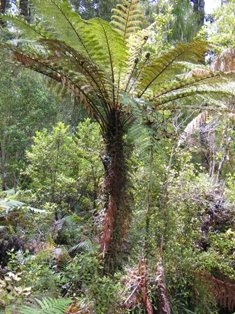 The sounds of bubbling brooks were never far away. We even encountered a mini-waterfall. Now and then, we just stood still and took in the crisp calls of the birds. Here, the solitude is inviting and the silence magical, especially at dusk.
The sounds of bubbling brooks were never far away. We even encountered a mini-waterfall. Now and then, we just stood still and took in the crisp calls of the birds. Here, the solitude is inviting and the silence magical, especially at dusk.
My suggestion for anyone going to Lake Matheson – don’t just get to the first lookout for the photos, walk the entire perimeter circuit. And end your walk with a drink at the Matheson Café. Sip your coffee and continue to enjoy the views to the Mount Cook.
Lake Matheson’s History:
18000 years ago, the glaciers retreated and the ice melt left an area quite flat. Rainforest grew and surrounded the area. The European settlers saw that the surrounding grassland was suitable for farming and converted most of the surrounding area into grazing farmlands.
Directions:
6 km drive from Fox Glacier Village. Turn right and drive for a minute to the car park.
Tuesday, March 21, 2006
New Zealand Scenic Drive 3 - Highway 94 Te Anau to Milford Sound
We decided to make Te Anau our base for the return day-drive to Milford Sound. We did not want to drive all the way from Queenstown – because you'll have less time for photo stops and the Milford Sound cruise.
Do take note that the road could be closed if an avalanche is impending. So check with the Information Center at Te Anau before proceeding.
We stopped at a few lovely places along the way – the Mirror Lake, the Hollyford Valley Lookout, the Chasm, and the Homner Tunnel.
Our first stop was the Mirror Lake. Here, you may take a 5-minute boardwalk stroll and stare at the calmness of the water. If you let your imagination stray a bit and just stare into the water for a while, you'll start to wonder....Where does the real image end and the reflection begin?

The Hollyford Valley Lookout is also worth a stop. There’s just something special about mountain slopes cloaked in evergreen vegetation.
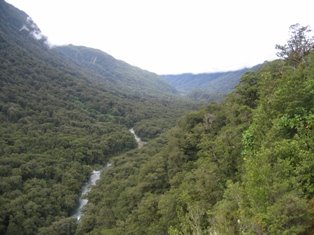
Our next stop, the Chasm, is not visually spectacular. However, if you are there on a sun-drenched day, you might get to see quaint little rainbows above the swashbuckling water – like we did.
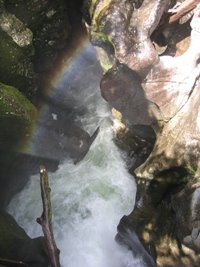
Also, you might want to stand on the walkway just above the water and listen to the crashing noise created by the gushing water. I stood there and felt a stirring awe. Notice also how the boulders and rock-faces have been carved and molded by the rushing waters.
The Homner Tunnel makes it possible to drive all the way to the Sound. But you have to wait for the lights to change because cars can pass only one way.
Meanwhile, get out of your car and soak in the sheer rock-faces here. On a rainy day, you could see surreal streaks of waterfalls flowing down these dark rock-faces. If the mist and clouds scud lowly across the area, you would be treated to a mystical panorama not unlike a scene from the Lord of the Ring.

The Road ends at the famous Milford Sound. Here, we booked a half-day cruise with the Red Boat company. I’ll write about the cruise in another post.
Tuesday, January 24, 2006
New Zealand Scenic Drive 2 – Highway 1 Blenheim to Kaikoura
20 minutes north of the Kaikoura township are the Ohau waterfall and seal colony.
The Ohau waterfall is not the huge and cascading type, but it is shrouded in thick vegetation and is hidden from the main road. It is not majestic, but if offers seclusion and solitude.
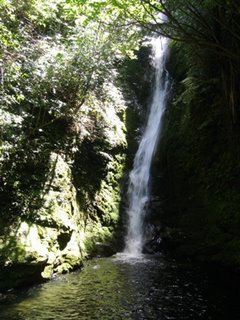
The seclusion of the Ohau Waterfall
The Ohau seal colony is less than 20 metres from the road. The seals can actually be seen from the road. There is no need to join a seal-watch tour; you can see them for free here. Pull up by the side of the road and come up close and personal with New Zealand fur seals. Be warned, however, that these seals can and WILL bite if you get too close and agitate them. Also the gulls here are noisy and suspicious of visitors to this rock outcrop.
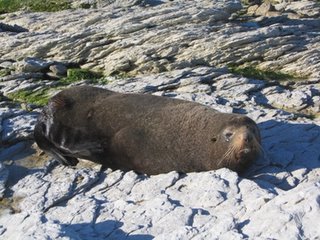
Fur Seal at the Ohau Seal Colony
End your drive further south at Kaikoura Town. Visit the information centre for updates about the tides if you intend on doing any coastal walk. Or drive all the way past the town towards the Fyffe Road car park, where you can walk to more seal colonies or do the Kaikoura Peninsula Cliff-top & Coastal Walk (highly recommended; see the views from here in my future post).
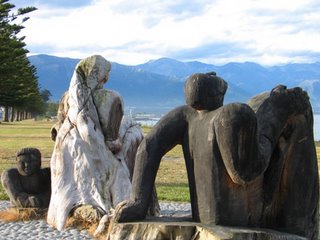
Sculptures along the Kaikoura Esplanade

View of Kaikoura from the start of the Peninsula Cliff-top Walk
Alternatively, bypass Kaikoura Town and head towards the beautiful South Bay Parade. Here, you can do we did - lay out your picnic mat and gaze at the unique opaqueness of the turquoise water.

South Bay Parade - a truly beautiful bay

The Kaikoura Range shrouded in mist
Sidebar
Kaikoura is big on whale- and dolphin-watching. But don't plan to arrive on Christmas Day. We did and found all the major operators closed for the holiday.
Wednesday, January 18, 2006
New Zealand Scenic Drive 1 - Highway 6 from Makarora to Wanaka
1. Highway 6 – From Makarora to Wanaka
2. Highway 1 – From Blenheim to Kaikoura
3. Highway 94 – The Milford Sound Road
My family did a New Zealand self-drive holiday in December 2005. I will share my experience along these routes in the next three blogs.
Highway 6 – From Makarora to Wanaka
Departing the abundant rainforests of the West Coast, we passed Haast and Makarora along Highway 6. The loveliest stretch begins when Lake Wanaka comes into view. The road skirts the edge of the Lake. Because it was a sunny day, the stunningly beautiful turquoise glow of the lake became a great distraction. So if you are at the driver's wheel, keep your eyes on the road. There are numerous spots to pull over for photos, so don't worry.
The road then veers away from Lake Wanaka's edge and enters a pass (=a passage through a mountain). Once we got onto the other side, we were awe-struck by the deep blue glint of Lake Hawea, set against the sometimes rolling and sometimes craggy peaks of New Zealand's Lakes District.
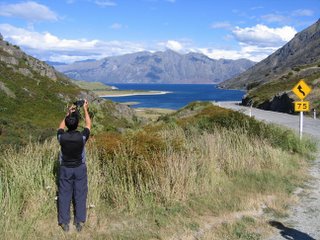
Photo opportunity just after the Pass (Lake Hawea)
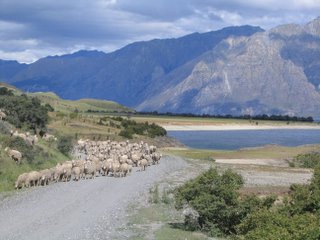
Traffic jam along a side-road to Lake Hawea
The drive ends at Wanaka town, where we planned our walks and adventure trips to the surrounding areas.
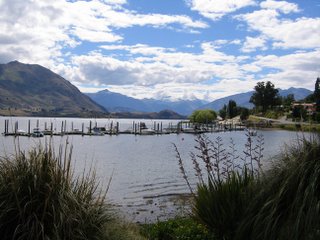
Boats berthed at Lake Wanaka
Sail boats in action on Lake Wanaka
Side Bar
Lakes Wanaka and Hawea were formed by the movement of massive glaciers over 10 000 years ago. The two lakes are close to each other and are separated by a small segment of land. Each is encircled by a pebbled shoreline. Stand at their edge and enjoy the superb views to the surrounding peaks. The lakes and surrounding areas afford lovely walks in summer. In winter, many skiers make Wanaka their base for ski trips to the surrounding mountains. Sailing, swimming, windsurfing, jetboating, parasailing, and fishing are also popular during the summer.





